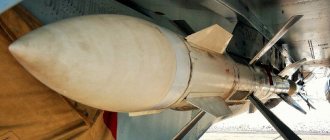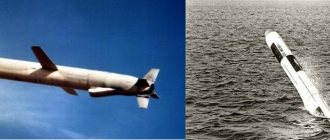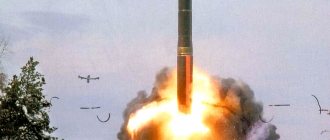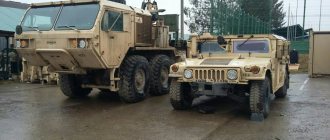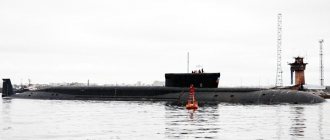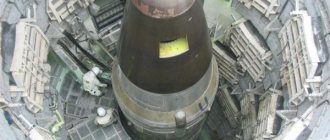Almost unnoticed was a media report on March 17 about the start of testing of the Russian Zircon hypersonic cruise missile. However, the military expert community managed to evaluate it. Essentially, this means that the Russian military-industrial complex has reached the finish line in creating a superweapon that potential enemies will have nothing to oppose in the near future.
Hypersonic missile "Zircon". Characteristics
NPO Mashinostroeniya has been developing the Zircon cruise missile since 2011. Its appearance and characteristics are strictly classified, which is understandable. It is only known that this is a sea-based missile with an estimated speed of Mach 5-6 and a flight range of 300-400 km. In the future, the speed can be increased to Mach 8.
According to some experts, the Zircon is essentially the same Russian-Indian supersonic BrahMos missile, only in a hypersonic version. If we continue its “pedigree” further, the new Zircon missile will turn out to be the “granddaughter” of the P-800 Onyx, on the basis of which the BrahMos was created.
By the way, in February last year, representatives of the Brahmos Aerospace company announced their readiness to create a hypersonic engine for a joint brainchild in the next 3-4 years.
Specifications
- The missile's flight range is 1,500 km.
- The installation has a speed of about Mach 6. (Mach 1 equals 331 meters per second).
- The ZK-22 warhead weighs at least 200 kg.
- 500 km is the radius of destruction of the Zircon hypersonic missile.
View gallery
The characteristics of the weapon give grounds to judge the superiority of the army wielding it over an enemy who does not possess such weapons.
First test results
The first tests of the Zircon rocket were carried out at the State Flight Test Center (Akhtubinsk) in 2012-2013. The long-range supersonic bomber Tu-22M3 was chosen to play the “role” of the carrier. Testing was continued 2 years later, but from a ground launcher.
Tu-22M3
The fact that Russia will soon have a new formidable weapon became clear after successful tests last year. Tests should be completed this year, and a year later Zircon is expected to go into mass production.
And at this time
Russia tested a new “hypersonic” missile, the Kh-47M2, in the Arctic. In mid-November 2020, a MiG-31 aircraft launched the Kinzhal missile for the first time in the Russian Arctic at the Pemboy test site located northeast of Vorkuta. According to a knowledgeable source, the missile reached a speed of Mach 10.
Kh-47M2 "Dagger" is a Russian hypersonic aircraft missile system capable of destroying stationary targets, as well as ships. The missile carrier is the Soviet MiG-31 interceptor, or rather, its new version, specially modernized for the use of the missile. According to previously announced data, such an aircraft is deprived of the ability to use standard air-to-air weapons and has the MiG-31K designation.
MiG-31.
The MiG-31 is a Soviet interceptor that entered service in 1981. The MiG-25 acted as the base for the aircraft. Today, the Aerospace Forces are actively operating a modernized version of the aircraft, designated MiG-31BM. It differs from earlier versions, among other things, in more modern on-board electronics.
The adoption of the Kh-47M2 hypersonic missile became known in 2020. A number of sources call the Kinzhal a hypersonic missile, however, according to other sources, we are talking about an aeroballistic complex, or more precisely, an air-launched version of the Iskander missile. According to data from open sources, the maximum range of the missile, excluding the combat radius of the carrier aircraft, is at least 1000 kilometers.
Problems encountered during development
For the Zircon anti-ship missile to become hypersonic, its creators had to work hard. One of the main problems is the monstrous overheating of the body during flight at hypersonic speed with the subsequent formation of a plasma cloud. As it turned out, one of the main missile systems, responsible for homing, is practically “blind” in it. It became obvious that Zircon would require a new generation of electronic components.
To accelerate the rocket, it was decided to use a ramjet rocket engine with supersonic combustion using fuel with increased energy intensity - “Decilin-M”. To solve the whole range of problems, the best Russian specialists in the field of aerodynamics, engine building, materials science and electronics were involved in the development of the product.
About prospects
The media is actively circulating information about the US lagging behind Russia in terms of developing hypersonic missiles. In their statements, journalists refer to data from American military research. The appearance of even more modern hypersonic weapons than the Zircon missile in the arsenal of the Russian Army is expected by 2020. For the US missile defense system, considered one of the most developed systems in the world, the emergence of extreme high-speed nuclear weapons in the Russian Air Force will, according to journalists, be a real challenge.
An undeclared high-tech arms race continues around the world. Hypersonic weapons are considered to be the latest technologies, which in the 21st century will play a decisive role in the outcome of war. It is no coincidence that in 2000, US President George W. Bush signed a directive making the possibility of launching a rapid global strike using hypersonic high-precision cruise missiles a reality.
It's easy to guess who it was intended for. This is probably why in October 2016, Russian Defense Minister Sergei Shoigu announced the use of the X-101, the latest cruise missiles with a range of about 4,500 km, in the war in Syria.
View gallery
The Zircon hypersonic missile, the characteristics of which guarantee a colossal advantage in armament for the army that possesses it, is the “golden dream” of any general, minister and president. The presence of such weapons can become a significant deterrent in any military conflict.
Prospects
Initially, the Zircons were designed as “aircraft carrier killers” - sea-based missiles that would be equipped with the 5th generation Husky nuclear submarines. However, it is not difficult to assume that over time they will be able to launch from surface ships, ground-based launchers and from attack aircraft.
Equipping the Russian Army with Zircon missiles could seriously affect the balance of forces. First, US carrier strike forces will become even more vulnerable. Secondly, the unique high-speed and maneuverable characteristics of the domestic hypersonic missile will reduce the effectiveness of the American missile defense system to almost zero.
Where are the new missiles planned to be used?
After the completion of further planned state tests, hypersonic missiles will be equipped with Huskies (multi-purpose nuclear submarines), Leader cruisers and the modernized nuclear cruisers Orlan and Pyotr Velikiy. The heavy nuclear cruiser Admiral Nakhimov will also be equipped with the Zircon anti-ship missile. The characteristics of the new ultra-high-speed weapon are much superior to similar models - for example, such as the Granit complex. Over time it will be replaced by ZK-22. Exclusively promising and modernized submarines and surface vessels will use the Zircon missile.
View gallery
Hypersonic projects of the USA and other countries
However, one should not write off the main Russian competitors.
Back in the early 2000s, during the presidency of George W. Bush, the development of the doctrine of rapid global strike began, where the main focus was on hypersonic cruise missiles with a range of 6000 km. As part of the doctrine, tests of the AHW missile are already underway, and next in line is the HTV-2 project to create a missile capable of reaching a speed of Mach 20 with a destruction range of 7,700 km. Last March, Lockheed Martin began developing the SR-72 hypersonic drone.
The hypersonic trend is the focus of China's military-industrial complex. So a year ago the hypersonic aircraft DF-ZF and Yu-71 were tested. India is developing the Shaurya tactical surface-to-surface missile, which can reach speeds of Mach 7. France is not far behind with its hypersonic air-to-ground cruise missile project ASN4G with a nuclear warhead and a speed of Mach 8.
Hypersonic race: supermissiles of three leading powers
Artist's rendering of DARPA's HTV-2
On May 15, US President Donald Trump made an interesting statement about promising weapons. He said that the United States has a kind of “super-duper-missile” that flies 17 times faster than those currently in service. He also remembered Chinese and Russian weapons, the speed of which is only 5-6 times higher. Was the US really able to break away from its competitors in the hypersonic race? Let's consider modern and promising developments of three countries - industry leaders.
Super rockets and hyperspeeds
According to known data, the USA and USSR/Russia began studying hypersonic aerodynamic flight several decades ago.
At the same time, the first experiments began using experimental aircraft, incl. with an eye to practical application. China joined such work later, only in the 2000s. However, this did not prevent him from quickly closing the gap and entering the narrow circle of world leaders. To date, the three countries have completed basic research work and moved to the stage of developing full-fledged weapons suitable for use by troops. In the coming years, full-scale deployment of hypersonic systems of various classes is expected in all branches of the military.
The new missiles and warheads will enter service with the ground forces, strategic missile forces, as well as the air and naval forces. However, countries’ specific plans for development and deployment differ markedly; everyone is betting on different areas.
American speed
Current US projects generally date back to the early 2000s and DARPA's FALCON program. Its main result was the experimental hypersonic gliding warheads HTV-2, which made two test flights. Launches took place in 2010 and 2011 and ended with mixed results. Both prototypes reached the required speed, but were unable to complete the entire intended route.
Infographics on the American LRHW project. Photo: Bmpd.livejournal.com
According to the test plan, the HTV-2 had to overcome a trajectory of approx. 7700 km with a maximum speed of 20M. Such tasks were only partially completed - both vehicles developed the required speed and remained on the trajectory for several minutes. However, long before the final point of the route, the first one self-destructed, and the second one fell into the ocean. However, in this case too, the HTV-2 set a speed record among experimental developments in the United States.
Subsequently, work was carried out on the AHW project. Prototypes of this type reached speeds of up to 8M. The LRHW interspecific missile system with the C-HGB gliding warhead is currently being created. Two test launches have already been carried out with speeds exceeding 5M (more precise values have not been reported). The complex is positioned as a medium-range system, which may indicate the possibility of launching at a distance of up to 5,500 km. In the near future, the LRHW will enter service with the ground forces, as well as the surface and submarine forces of the Navy.
Of great interest is the project of the air-launched missile AGM-183A ARRW, which is preparing for flight tests. The tactical and technical characteristics of this product have not yet been announced, which contributes to the emergence of the most daring versions. Some estimates go up to a maximum speed of 20 Mach - but it is not yet clear how true they are.
Thus, the United States has the technology to create hypersonic systems with speeds up to 20M and a range of approx. 7-8 thousand km, although not all such possibilities have been confirmed by practice. Products with lower characteristics are being successfully tested - also sufficient to solve combat missions.
Russian developments
Consideration of the Russian hypersonic program should begin with a complex that has passed all tests and is put on combat duty. In December 2020, the Strategic Missile Forces began operating the Avangard product, which was the result of many years of research and testing. According to known data, the complex includes the UR-100N UTTH missile and a special warhead equipped with the Avangard unit.
Presumably, the combat unit of the Avangard complex. Photo by the Russian Ministry of Defense
According to officials, the speed of the Avangard on its trajectory exceeds 20 Mach. Flight range is intercontinental. There is the ability to maneuver in speed and heading. An effective control system is provided, ensuring quick preparation for the launch and successful solution of the task.
The Kinzhal complex with an air-launched ballistic missile has been brought to the stage of experimental military operation. Using a MiG-31K or Tu-22M3 carrier aircraft, it is delivered to the launch line, after which it flies along a ballistic trajectory with an altitude of at least 20-22 km. The maximum speed is more than 10 M, the range without taking into account the carrier parameters is 2000 km.
The Zircon anti-ship missile system with the 3M22 missile is being created for the Navy. To date, it has begun testing on offshore platforms and is expected to enter service in the near future. During test launches, Zircon reached a speed of 8M. The range, according to various sources, reaches 400-800 km. The missile with the container is placed in the cell of the 3S14 universal launcher, used on many ships. It ensures reliable destruction of large surface ships.
In the past, several large development projects were carried out in our country, the results of which are now being used in real projects. There are technologies that make it possible to accelerate equipment to speeds of about 20M and send it to intercontinental ranges. What’s even more important is that all these developments have been brought to the point of testing, at a minimum.
Chinese secrets
China is in no hurry to reveal its secrets in the field of promising technologies, but others are doing it for it. Thanks to foreign intelligence services and the media, it became known about the existence of a project with the symbol WU-14 or DF-ZF, which provides for the construction of a missile system with a hypersonic warhead.
MiG-31 with the Kinzhal missile. Photo by the Russian Ministry of Defense
Flight tests of the WU-14 began in 2014. To date, up to 10 launches have been carried out with varying results. The Chinese Ministry of Defense confirmed information about the first launches, but claimed that they were of a purely scientific nature. According to foreign estimates, the DF-ZF unit on its trajectory develops a speed of no more than 10M. Previously it was stated that DF-21 or DF-31 ballistic missiles, capable of providing a maximum range of up to 3 or 12 thousand km, could be used as a carrier. Last year, the DF-17 missile was shown for the first time, which provides a range of up to 2,500 km.
According to known data, the DF-ZF unit and the DF-17 missile entered service with the Chinese Strategic Missile Forces and are now on duty. It is possible that other types of hypersonic weapons are being developed, but there is no information about them yet.
Hypersonic race
Technologies for creating hypersonic aircraft, incl.
warheads of missile systems are available to the three leading powers, and they continue to develop this direction. At the same time, there is a clear leader, followed by other countries. Based on the totality of technical characteristics and achieved successes, they should be recognized as Russia. It was our country that not only created and tested, but was also the first to put several models of promising weapons on duty at once. Even US officials admit that they are lagging behind Russia. In second place we can put the PRC, whose army has so far received only one hypersonic complex. However, if we take into account the dates of adoption, China is the first.
Parade formation of Chinese DF-17 complexes. Photo Nevskii-bastion.ru
The Russian hypersonic program has already produced three types of weapons to solve various problems, from operational-tactical to strategic. In addition, large ranges of speeds and flight ranges are covered, which is ensured by more complete use of available technologies. China cannot yet boast of such successes, although new projects can be expected to appear in the near future.
To the displeasure of D. Trump, the United States is still in the position of catching up. They have several promising models, but none of them have yet reached combat duty. In terms of speeds and ranges, the situation is no better. The samples intended for adoption have not yet outperformed their competitors. As for the “super-super rocket 17 times faster than others,” it is expected to be in arsenals only by the middle of the decade at best.
However, the American president can be pleased. The hypersonic race of the leading powers is not ending. It seems that she is just approaching her most active phase. Thus, competing countries have the opportunity to continue work, obtain the desired results and set new records, ensuring strategic national security. And at the same time, get a reason to be proud of your science and technology.
Perspectives and criticism
According to the project, the new generation Zircon 3M22 anti-ship cruise missile is universal and can be used by almost all ships, as well as the army (ground forces), military space forces, etc. However, due to the small amount of official information, many aspects of the design remain controversial.
| Problem | Possible Solution |
| Performance of a radio channel or homing head under conditions of aerodynamic heating. When flying in low layers of the atmosphere, the projectile is surrounded by a plasma cloud (a layer of ionized gases) and a serious distortion of target designation and radio traffic occurs. For space descent vehicles, this problem has not been solved. | Nuclear warhead and a huge target (for example a small city) |
| Reducing speed to transonic (Mach number = 0.8) near the target, turning on the homing head | |
| After determining the coordinates of the target, separation of the power plant (using pyro devices) and hitting the target with a gliding combat homing module (also less noticeable). | |
| High-precision satellite guidance, the strike is delivered by “smart” homing darts or high-explosive projectiles (a very controversial solution, like a thermal imaging homing head) | |
| Window for radio waves in the tail of the rocket (external control channel), multiple repetition of commands | |
| Low noise immunity of existing anti-ship hypersonic cruise missiles | |
| The radar homing head may melt due to aerodynamic heating | Adopting high temperature oxide ceramics for fairings and body (can withstand 1500 degrees) |
See also the article Tomahawk cruise missile and its modifications
If all possible problems are successfully resolved, Zircon is a weapon that threatens to become exactly the formidable answer as it is positioned in the media. It is expected that the new Zircon missile will reduce the importance of aircraft carriers and capital ships in battle, and also encourage other states to modernize ship-based air defenses.
Background of the Russian hypersonic cruise missile
The Soviet Union was the first to arm itself with serial anti-ship cruise missiles. Zircon has become the latest development of Russian scientists. And the first copy was the Termit missile (P-15). In the 70s, supersonic and hypersonic cruise missiles of a new generation (X-50) were developed, but the work was not completed due to the collapse of the USSR.
1965
this year the “Spiral” project was launched
The first hypersonic aircraft would be a booster aircraft for the Spiral (orbital aircraft) project, which began in 1965.
The reconnaissance disperser, also known as the “50-50” product, is:
- 38-meter tailless aircraft;
- delta wing with fender length 16.5 m;
- lowerable bow;
- hypersonic air intake;
- fundamentally new turbojet engines: kerosene: M=4, range = 6-7 thousand km, liquid hydrogen: M=5, range = 12,000 km.
The plane was tested at TsAGI, but in the 70s the project was also closed.
In 1979 they returned to the topic of hypersonic engines. To recreate their operating conditions, anti-aircraft missiles were used: instead of a warhead, a block with equipment for testing was installed.
- Based on the 5V28 missiles, which were just about to be decommissioned, there was a hypersonic flying laboratory “Kholod”. For seven launches in 1991-1999. The operating time of the tested E-57 engine was increased to 77 seconds, the speed was increased to 1855 m/s (~6.5M);
- The Igla flying laboratory was created on the basis of the Rokot launch vehicle (a descendant of the intercontinental UR-100N). The model of which can still be seen at air shows. Laboratory operating conditions: M = 6-14, altitude = 25-50 km, flight time – 7-12 minutes.
